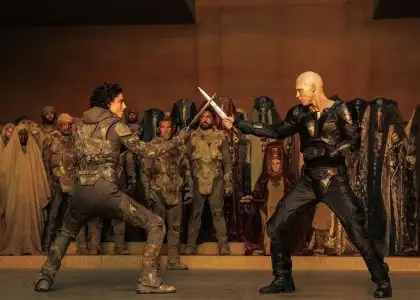New Villains, Bigger Worms: 'Dune: Part Two' Is a Pure Visual Spectacle

Warning: Spoilers alert!
Spiceheads, are you ready for a cinematic trip to Arrakis? The blue-eyed Fremens and gigantic sandworms are back!
The eagerly anticipated movie adaptation of Frank Herbert’s 1965 novel “Dune: Part Two” hit theaters in the Philippines on Feb. 28, starring Timothée Chalamet, Zendaya, Florence Pugh, Austin Butler, and Anya Taylor-Joy, with the direction of Denis Villeneuve.
Despite the setback from its original launch date of Nov. 3, 2023, the follow-up film didn’t disappoint fans, accumulating a whopping US$81.5 million in ticket sales upon its initial release in Mexico City on Feb. 6 by Warner Bros. Pictures. To clarify, this is not a sequel to the initial “Dune” movie, but rather a second part or continuity of the first installment released in 2021.
In case you haven't seen it, prepare yourself for a visual delight packed with stunning actions and aural effects. Expect a blend of epic battle scenes, interstellar politics, and more divisive issues.
Acting and Performances
Leading the charge is “Call Me By Your Name” breakout star Timothée Chalamet, who reprised his role as Paul Atreides for the movie’s part two.
While Chalamet showcased notable portrayals in his past roles, audiences wonder if he might hold back from fully exploring the depths of his emotional range. The film, however, gives him a dramatic backstory to work with: he is a duke from an exiled royal house whose father was killed amid conflict and chaos. There is anticipation for him to deliver a wider spectrum of emotions for his talent to further shine — and he does. His portrayal is one of quiet intensity; it is reflected in his steely, tempered eyes and a voice filled not with blind rage but with resolve and reasoning as he chooses duty over love.
This particularly resonated in the scene where he accepts his fate as the Lisan Al Gaib and decides to marry Princess Irulan (played by Florence Pugh) despite his deep affection for Chani (Zendaya).
Compared to the first part of the movie, fans were quick to notice that Zendaya was given expanded screen time for part two, mainly as the love interest of Paul. Their blossoming romance unfolded after Chani became a pseudo-mentor for Paul prior to his duel with Jamis.
Zendaya proved that she’s perfect for the role of Chani with her impressive acting skills as a competent fighter ingrained in Fremen's traditional culture. She also flawlessly demonstrated Fremen’s survival instincts and fearlessness as a Fedaykin, a member of the elite death commandos of the group.
The introduction of additional characters, such as Feyd-Rautha Harkonnen (Austin Butler), Princess Irulan (Florence Pugh), and Alia Atreides (Anya Taylor-Joy), injected fresh intrigue into the franchise.
Butler delivered excellent acting and left a lasting impression on fans as a sociopathic villain. Although fewer scenes were given to Pugh and Taylor-Joy, the two actresses were able to demonstrate the strength and complexity of their characters, who both possessed an ethereal presence.
Plot and Storytelling
Set on the desert planet of Arrakis, “Dune: Part Two” follows the story of Paul as he plans to wage war against the Harkonnens led by their ruthless ruler Baron Vladimir Harkonnen, and supported by Padishah Emperor, Shaddam IV.
What sets the movie apart from other sci-fi films is its smooth transition between scenes, which paves the way to build each character as the story progresses. Similar to what was written in the book, the new cast members in part two were unveiled with flair without confusing the viewers about their origins or any sudden appearances.
The movie also introduced various factions or powerful noble houses that enhanced the plot. However, they could’ve delved deeper if they touched upon the roles of Spacing Guild and Combine Honnete Ober Advancer Mercantiles (also referred to as CHOAM), as these organizations have the power and influence over money and trade within the “Dune” universe.
The story also sheds light on the reclusive society of Fremen as desert dwellers clad in water-preserving ensembles called “stillsuits.” With each revelation — from Fremen’s skills in crafting crysknife (sandworm teeth) as weapons to the importance of walking in irregular patterns that emulate the natural shifting of rocks and sand to avoid attracting the colossal sandworms — richness is added to the storyline.
Furthermore, the plot bears a resemblance to the medieval fantasy series “Game of Thrones,” which both tackled rivalries for the throne and the sacrifices of the characters for the sake of power, bloodlines, and lineage.
It was also interesting to note that, despite being a sci-fi movie, “Dune: Part Two” did not feature traditional technologies such as computers or robots. The timeline happened 10,000 years into the future or long after the era of artificial technology (AI). However, the technology became powerfully smart which resulted in an AI revolt, leading to the destruction and banning of all forms of AI in the universe.
This circumstance shows relevance to the ongoing debate about the potential of AI to replace and outperform human intelligence in the workforce.
Themes and Messages
Amidst the unearthly world of “Dune,” the film adeptly explores profound themes associated with the realities of human experience.
The movie revealed several truths and enlightenments, such as the powerful nature of religion and other biblical themes. The belief system in “Dune” was inspired by the Abrahamic religions (Judaism, Christianity, and Islam), with Paul as their messiah or Christ-like figure. Despite having non-believers among the Fremen about Paul’s prophecy, he and his mother Lady Jessica effectively brought together an army by using the people’s faith and giving them something to hope for. This scene serves as a cautionary tale to demonstrate the dangers of having or following a false Messiah.
The film also sheds light on violence through various factions that vie for dominance and access to melange — a spice that can extend human lifespan and facilitate interstellar travel. Melange can be likened to fossil fuels such as coal, oil, and gas, upon which humanity heavily relies for electricity, transportation, and technological progress.
The story also underscores ecological themes, such as water scarcity and climate change; although subliminal, it reflects the importance of natural resources, considering the desert planet of Arrakis has extreme water scarcity.
Apart from the stillsuits worn by Fremen to collect and filter their body’s perspiration and other bodily fluids, converting them into potable water, the Fremen also developed deathstills to extract water from a dead body, emphasizing the desperate lengths to which they must go to ensure survival.
Through the lens of Arrakis, the film reminds viewers to value and protect our natural resources, lest we face the dire consequences of their depletion.
Cinematography and Direction
The movie is a wonderfully immersive watch and is worth seeing in premium formats such as IMAX or 4DX. A particular episode that stood out was when Fremen leader Naib Stilgar (Javier Bardem) challenged Paul to ride the sandworm to prove himself as the worthy Lisan al Gaib or the prophesied savior of the Fremen.
In a daring display of courage, Paul accidentally summoned a massive sandworm that measured about 90 feet long and 24 feet wide. The worm-riding scene was indeed breathtaking, immersing the viewers in the thrill of the moment complete with believable wind and sand effects as Paul gripped the rough ride using the special hooks used by Fremen. This sequence was able to capture the essence of how readers might have envisioned it while reading the book.
“Dune: Part Two’s” cinematography will also transport its audience to the monochromatic world of Harkonnen, achieved using black-and-white infrared lighting by cinematographer Greig Fraiser.
From intimate close-ups and breathtaking wide shots, the arena fight scene featuring Feyd-Rautha was masterfully done as it revealed the intricacies of Giedi Prime, a planet characterized by a volcanic environment and drenched under the eerie glow of the Black Sun.
Overall, the movie is a masterpiece with Villeneuve’s skillful direction, balancing the sequences with pulse-pounding action and introspective moments. The adaptation stayed true to Herbert’s novel while also introducing fresh elements for audiences anew. Viewers, however, need to learn and familiarize themselves with the terminologies used in the “Dune” world to further understand the depth of the story.
Watch “Dune: Part Two” via SM and Ayala Mall cinemas nationwide.
Get the latest curated content with The Beat Asia's newsletters. Sign up now for a weekly dose of the best stories, events, and deals delivered straight to your inbox. Don't miss out! Click here to subscribe.
















































